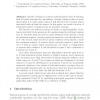Free Online Productivity Tools
i2Speak
i2Symbol
i2OCR
iTex2Img
iWeb2Print
iWeb2Shot
i2Type
iPdf2Split
iPdf2Merge
i2Bopomofo
i2Arabic
i2Style
i2Image
i2PDF
iLatex2Rtf
Sci2ools
108
Voted
ALGOSENSORS
2009
Springer
2009
Springer
Approximating Barrier Resilience in Wireless Sensor Networks
Barrier coverage in a sensor network has the goal of ensuring that all paths through the surveillance domain joining points in some start region S to some target region T will intersect the coverage region associated with at least one sensor. In this paper, we revisit a notion of redundant barrier coverage known as k-barrier coverage. We describe two different notions of width, or impermeability, of the barrier provided by the sensors in A to paths joining two arbitrary regions S to T. The first, what we refer to as the thickness of the barrier, counts the minimum number of sensor region intersections, over all paths from S to T. The second, what we refer to as the resilience of the barrier, counts the minimum number of sensors whose removal permits a path from S to T with no sensor region intersections. Of course, a configuration of sensors with resilience k has thickness at least k and constitutes a k-barrier for S and T. Our result demonstrates that any (Euclidean) shortest path ...
Related Content
| Added | 25 May 2010 |
| Updated | 25 May 2010 |
| Type | Conference |
| Year | 2009 |
| Where | ALGOSENSORS |
| Authors | Sergey Bereg, David G. Kirkpatrick |
Comments (0)

